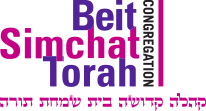
Accessibility
CBST’s street-level location is fully accessible, and accessibility of all kinds is a key priority at CBST to ensure that each person who comes through our doors, who joins us online for a gathering, or who joins us off-site for a service can feel comfortable to bring their full self.
We want to hear from you about what would help CBST be most comfortable to you. Email accessibility@cbst.org for more information or to share suggestions.
What makes CBST’s home physically compliant with the Americans with Disabilities Act (ADA) (and beyond)?
- Mobility. Our front doors open directly onto street level, with no steps or ramp necessary to enter the main space of the building or sanctuary. Every level of the building is accessible, thanks to a retrofitted elevator. We have bench seating in the sanctuary in multiple reconfigurable positions, as well as a ramp to the bimah and the ark. There are more ADA-accessible toilet stalls than code requires, and our all-gendered bathrooms allow someone needing assistance to be accompanied by a helper of any gender. The exterior and interior foyer doors have push-button automated openers, and there are mezuzot at the entrances to our building, the sanctuary, and the chapel at a height that is reachable for a seated user passing through doorways.
- Vision. Lighting in our sanctuary is strategically placed so that every participant has a direct light source for ease of reading text. The space is designed so that all seats in the sanctuary are within 25 feet of the bimah, and high-contrast lighting makes our space more easily navigable for those with less acute vision. The typeface in our signage has been evaluated for ease of legibility, and there is Braille lettering on signs and elevator buttons.
- Hearing. We have an Inductive Hearing Loop* integrated on both levels of the sanctuary and in the chapel. Audio speakers subtly reinforce the sound from the bimah throughout the sanctuary. We have personal sound receivers available on request for anyone who does not have a T-coil hearing aid. In addition, there is acoustic separation between rooms, so that background noise is reduced and does not interfere with speech intelligibility. And the acoustics of the sanctuary and other spaces have been designed so that sound carries well, but is not overly reverberant.
*An Indictive Hearing Loop generates a signal that can be picked up by hearing aids and cochlear implants with a built-in telecoil (T-coil). Unlike traditional one-size-fits-all headset systems, the Loop signal is picked up by a hearing aid designed for an owner’s particular type of hearing loss. The Loop signal eliminates much of the background noise and boosts sounds that are farther away, providing clear sound and a much improved experience. Loops are ubiquitous in Northern Europe, and the US is working to catch up. Here in New York City, Loops have been installed in Temple Emanu-El and Brotherhood Synagogue. You can also find Loops at the Gershwin Theatre, the Richard Rodgers Theatre, the Manhattan Theatre Club, the Atlantic Theater Company; at box offices & ticket windows at MOMA, the Met, Amtrak, Metro North, and Citifield. Loops are also installed in newer NYC taxis.
Questions/concerns? Contact us
